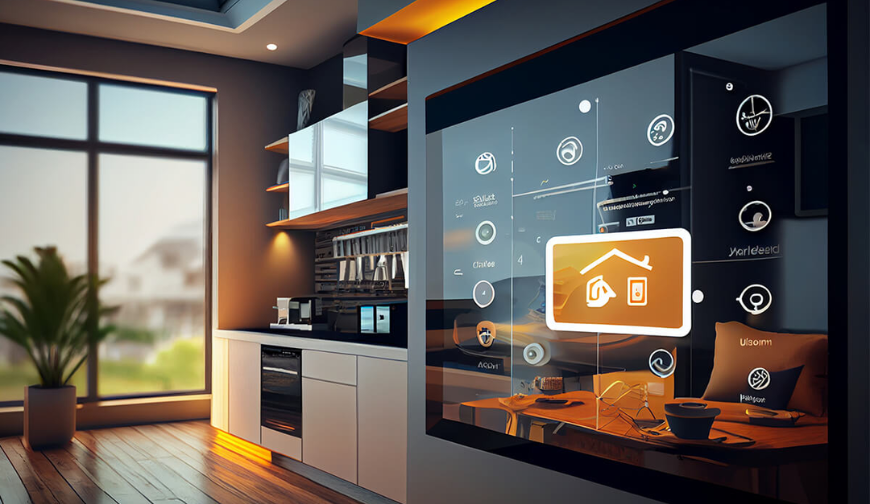In recent years, the concept of smart homes has gained significant traction, promising to revolutionize the way we live. Smart homes are equipped with various interconnected devices and systems that can be remotely controlled and automated. These homes utilize advanced technologies such as artificial intelligence (AI) to enhance convenience, efficiency, and security for residents.
Evolution of Smart Homes
Early Beginnings
The idea of automated homes traces back to the early 20th century, with inventions like the thermostat and remote-controlled appliances. However, it wasn’t until the late 20th century that significant advancements in computing and connectivity laid the foundation for modern smart homes.
Advancements in Technology
The proliferation of the Internet of Things (IoT) and wireless communication technologies has propelled the evolution of smart homes. Today, homeowners can seamlessly control various aspects of their homes using smartphones or voice commands.
Components of a Smart Home
A smart home comprises several key components:
Smart Devices
These include smart thermostats, lighting systems, security cameras, door locks, and appliances, all interconnected and controllable through a central hub or mobile app.
Connectivity Systems
Robust Wi-Fi networks and protocols like Zigbee or Z-Wave facilitate communication between devices, ensuring seamless integration and interoperability.
AI Integration
Artificial intelligence plays a pivotal role in smart homes, enabling devices to learn user preferences, anticipate needs, and optimize energy usage.
Benefits of Smart Homes
Convenience
Smart homes offer unparalleled convenience, allowing users to automate routine tasks such as adjusting temperatures, turning on lights, or locking doors with simple voice commands or preset schedules.
Energy Efficiency
By intelligently managing energy consumption, smart homes can reduce utility bills and minimize environmental impact through features like automated lighting, heating, and cooling systems.
Enhanced Security
Advanced security systems with AI-powered surveillance cameras, motion sensors, and smart locks provide round-the-clock monitoring and real-time alerts, enhancing home security and peace of mind.
Challenges and Concerns
Privacy Issues
The collection of vast amounts of personal data by smart devices raises concerns about privacy and data security, necessitating robust privacy policies and security measures.
Interoperability Problems
Compatibility issues between different smart devices and platforms pose challenges for users seeking seamless integration, highlighting the need for industry-wide standards and protocols.
Cost Considerations
The initial investment required to outfit a home with smart devices and systems may deter some homeowners, although the long-term savings in energy costs and added convenience often outweigh the upfront expenses.
AI Integration in Smart Homes
Voice Assistants
Virtual assistants like Amazon’s Alexa, Google Assistant, and Apple’s Siri serve as the primary interface for controlling smart devices, responding to voice commands, and providing personalized assistance.
Predictive Analysis
AI algorithms analyze user behavior and environmental data to predict and adapt to users’ preferences, optimizing settings for comfort, efficiency, and convenience.
Adaptive Automation
Smart homes employ AI-driven automation to anticipate users’ needs and adjust settings accordingly, whether it’s adjusting the thermostat based on weather forecasts or turning off lights in unoccupied rooms to conserve energy.
Applications of AI in Smart Homes
Home Automation
AI enables seamless automation of various tasks, from adjusting climate control and lighting to scheduling household chores, freeing up time for residents to focus on more meaningful activities.
Energy Management
By analyzing energy usage patterns and external factors like weather forecasts, AI algorithms optimize energy consumption, resulting in significant savings on utility bills while reducing carbon footprint.
Health Monitoring
Smart home devices equipped with AI can monitor occupants’ health parameters, detect anomalies, and alert caregivers or emergency services in case of medical emergencies, enhancing safety and wellness.
Future Trends in Smart Home Technology
Expansion of IoT
The Internet of Things will continue to expand, with more devices becoming interconnected and intelligent, creating a networked ecosystem that seamlessly integrates into daily life.
Integration with Wearables
Smart homes will increasingly integrate with wearable devices like smartwatches and fitness trackers, enabling seamless interaction and personalized experiences based on users’ health and activity data.
Personalized Experiences
AI-driven personalization will become more sophisticated, tailoring smart home environments to individual preferences, habits, and schedules, enhancing comfort and convenience for residents.
Impact on Daily Life
Smart homes are poised to revolutionize daily life in numerous ways:
- Simplifying Daily Tasks: Automation streamlines routine chores, freeing up time for leisure activities or personal pursuits.
- Redefining Home Security: Advanced security features provide peace of mind, allowing residents to monitor and protect their homes remotely.
- Transforming Entertainment: Integrated audiovisual systems and immersive experiences enhance entertainment options, bringing cinema-quality viewing and gaming experiences to the comfort of home.
Conclusion
Smart homes represent the pinnacle of modern living, leveraging AI and advanced technologies to create automated, efficient, and secure living spaces. While challenges such as privacy concerns and interoperability issues remain, the benefits of convenience, energy efficiency, and enhanced security make smart homes an enticing prospect for homeowners worldwide.
FAQs
- Are smart homes secure from hacking?
- Smart homes employ robust security measures such as encryption and authentication protocols to safeguard against cyber threats. However, users must also take precautions such as regularly updating software and securing their home networks.
- Do smart homes save energy?
- Yes, smart homes optimize energy usage through features like automated lighting, climate control, and appliance management, resulting in significant energy savings over time.
- Can I retrofit my existing home into a smart home?
- Yes, many smart devices are designed for easy installation and integration into existing homes, allowing homeowners to gradually upgrade their living spaces to smart homes.
- What happens if the power goes out in a smart home?
- In the event of a power outage, some smart devices may lose connectivity temporarily. However, many devices have battery backups or alternative power sources to maintain essential functions.
